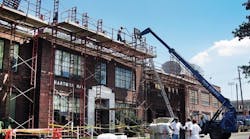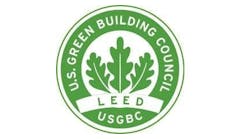Your building envelope protects the inside of your facility from the elements, but when it fails and allows thermal and moisture leaks to appear, costs add up whether that’s through reduced energy efficiency, reduction in occupant productivity or the extensive repairs that inevitably come with these problems.
but they are often not insulated. New buildings, on the other hand, are typically well insulated
but have many thermal bridges that allow heat transfer. Photo by Walter P. Moore
While these issues can often be hard to track, it is important to put your best foot forward by being proactive and implementing the right practices to keep water out and regulate the air in your building.
Are you doing enough to make sure your building enclosures are properly sealed?
Where to Find Moisture Leaks
Moisture leaks can be a major thorn in the side of FMs because of the cost and widespread effects they can have on the entire building environment. Physical water penetrating the envelope typically happens through some inadequate component of construction. Various factors lead to leaks that can spread into your building, such as faulty weather and vapor barriers, the use of incompatible materials in the envelope or rushed construction, explains Sage Lehr, Engineering Manager at IWR North America, a St. Louis-based building enclosure contractor.
In buildings with many levels, be sure to pay close attention to the exterior wall at floor lines; moisture leaks commonly develop in these spots.
The most logical place to look for moisture leaks is at transitions between systems and materials. These areas provide the easiest access for water to enter from the exterior of the building.
“You’ll find leaks between the roof and the wall and between the wall and a fenestration system. Those are the first places we look,” says David T. Ford, Principal and Managing Director of the Diagnostics Group at multidiscipline engineering firm Walter P. Moore in Kansas City, MO. “Often, you’ll have failure within a given system like in a window system, a brick veneer or stucco because the detailing within the system may have some issues. Usually, the most logical place to look first is the transitions between systems and materials.”
Specifically, Lehr identifies the following as some of the key places where moisture leaks are most common:
- Roof membrane to wall vapor barrier line
- Control and expansion joints in walls
- Wall vapor barrier to curtain wall transitions at the jambs, heads and fills
- Walls at floor lines
- Incorrectly installed flashings
One particular component key to preventing moisture leaks is a properly installed flashing. Although often overlooked, flashings are vitally important to the building envelope because they serve as a last defense for the building to fend off water penetration at transitions.
Without proper flashings, it does not matter how well the rest of the envelope along that transition is constructed; water will find a way.
“You need a flashing – sometimes it’s metal and sometimes it’s a sheet membrane – that makes that transition between two different systems so you don’t have a leak there,” says Ford. “If those flashings are either missing, not installed correctly or just worn out due to age, that’s where you’ll get a leakage failure on the walls.”
In addition to requiring costly repairs, moisture problems in buildings affect performance. As water penetrates the building over time, building materials like insulation, for example, do not perform as well. As damage spreads, the number of problems it creates increases.
Read also: How to Install Rooftop Equipment the Right Way
“The issues cause the wall insulation to not perform to the specified R-values when moisture gets in. They can cause materials to rot and corrode at a higher pace. Of course, there are health and mold issues that impact that as well,” Lehr explains.
Coughing Up Money
In addition to the costs of repairing neglected moisture leaks making a dent in your budget, water issues in the envelope can negatively affect occupant wellness and productivity.
“Once you get deterioration inside your wall, it starts affecting the structural system and interior drywall,” says Ford. “It can lead to biological growth either inside the wall or on the surface of the interior wall. From there, that can cause problems for building occupants.”
Lawrence Berkeley National Laboratory estimates that asthma-related medical costs attributable to mold and dampness exposure add up to roughly $3.5 billion each year, and this figure does not take into consideration other health effects building mold causes. Ensuring that moisture problems do not create widespread biological growth can help your organization save significantly.
The Environmental Protection Agency lists the following costs associated with moisture issues in the building envelope:
- Absenteeism due to illnesses like asthma
- Reduced productivity due to moisture-related health and comfort problems
- Increased insurance risk, repair and replacement costs associated with corroded structural fasteners, wiring and damaged moisture-sensitive materials
- Repair and replacement costs associated with damaged furniture, products and supplies
- Loss of use of building spaces after damage and during repairs
- Increased insurance and litigation costs related to moisture damage claims
Ultimately, by the time you have mold appearing in your facility from a moisture leak, the damage has been done, Ford explains: “If you have biological growth, you probably have a much bigger problem than you realize.”
It can be difficult to catch moisture problems before biological growth appears, so you will need to make sure you take every precaution to detect leaks before they can spread.
Common Mistakes
When FMs are faced with a moisture leak problem, mistakes can easily be made that make things worse. Ford identifies three key mistakes that allow moisture leaks to cause even more damage and cost more money.
1) Not going after the source of the leak. The most commonly made mistake is addressing the leak where it comes in on the inside rather than the outside. Simply covering it up from the inside might seem like the simpler fix, but it is merely cosmetic. The original leak on the exterior of the building will still be an issue that won’t go away until it is dealt with directly.
2) Neglecting the problem altogether. Some FMs simply let the exterior wall leak and don’t do anything about it. An “out of sight, out of mind” approach will only prolong the problem and increase eventual expenses.
3) Performing a temporary fix. While some FMs will go to the outside to solve the problem, the solution they put in place is not adequate because it is merely a temporary solution. Simply adding sealant or applying tape to the affected area on the exterior is not enough.
More: Top 5 Envelope Failures and Water Leaking Solutions
“Those temporary fixes are temporary. They may last a week or they may last a year, but they need to be incorporated into something comprehensive, which means you have to take apart parts of the facade to do it the right way,” says Ford. “That’s what we see often where someone goes with a quick-fix repair that doesn’t last very long, and then that repair leads to other damage as the water just finds another pathway.”
Successfully remedying an exterior moisture leak requires thoughtful collaboration with a building envelope expert. However, an active diagnostics plan can help you find these problems early on, which can reduce the emergence of widespread problems altogether.
Be Proactive
In order to stay ahead of envelope issues, take a more proactive approach. Rather than waiting for a costly problem to appear, regular checks with a consultant might allow you to get ahead of moisture leaks and save money in the long run.
Ford suggests that you inspect annually, depending on the building. Performing a visual survey with envelope experts is a good practice, and having your maintenance team look for visual issues also gives you a chance to stay ahead of the game. Springtime can be a particularly good time to do an annual check so you can take stock of conditions after winter.
“If you’re a proactive owner, there are some things we can do from a consulting perspective where we would do a visual assessment of the building and look for some typical visual keys that could be a sign of moisture or thermal infiltration. We can also perform water testing and infrared thermography of a building from the inside or the outside,” says Ford. “Even if you don’t hire a consultant annually, at least go around and look for any issues yourself.”
New Technology: Deploy Drones for Envelope Inspections
But if you do inspections on your own, you might miss something that a consultant would be able to catch earlier. In some cases, it might not be possible to find problems on your own, but if a leak eventually reveals itself as a serious problem, contact a specialist soon.
“Often the maintenance manager or the owner doesn’t find the signs until the damage is already done,” explains Lehr. “But once there are signs of moisture infiltration, it’s crucial to report that moisture problem and get a specialist to investigate the problem. The sooner it gets resolved, the better. The longer moisture sits, the more it spreads and does more damage.”
No Half Measures
Once you find a moisture leak issue in your facility, the clock is ticking and you need to ensure that you resolve the issue completely. FMs that wait or inadequately fix moisture leaks typically face much larger problems down the road.
With budgets weighing heavily on FMs, some are pressured into make poor decisions that only reduce costs in the short term. Instead of fully addressing the problems in the exterior wall, some FMs try to come up with a temporary fix that they assume they can continue to apply over time. Others might completely ignore the problem with the hopes that it won’t cause any long-term consequences.
But as the leak overcomes the half-hearted effort or becomes too widespread, costs skyrocket.
“It’s not good to ignore the leaks or cover them up. That always leads to spending more money,” Ford explains. “The cost in the short term seems like a lot of money where you have to spend $5,000 to put in the right flashing, but you don’t have $5,000 so you do a $500 repair and ignore it for five years. Then we get brought on board as a consultant and see what’s going on – the temporary repair didn’t work. Now you have more damage and are addressing the structure or the interior finishes. Instead of paying $5,000, you have to spend $50,000.”
Related: 4 Biggest Building Maintenance Challenges and Solutions
While you might be addressing one specific failure in the envelope, it might be a good opportunity to find any other similar issues that have started to form. What went wrong in one particular location might be happening in an area that is constructed in the same way.
“The priority is to get a specialist out there and investigate the situation. Where is it coming in and why?” says Lehr. “Find out what the issue is and address it. At that point, it may be a great time to inspect the other area for similarities to make sure it is a one-time occurrence. If it’s a reoccurring issue at other areas with the same type of detail or intersection, then that would be a prime time to inspect those and make sure you don’t have the same problems in the same types of areas.”
Leaks can happen anywhere in a building, so don’t think about envelope leaks as isolated incidents. When working with a specialist, be thorough and prepare to find leaks in any number of locations.
5 Money-Saving Envelope Product Winners for 2018
“In most buildings it’s not just one source of the leak; it’s multiple sources. You have to peel the onion and fix it in phases because you’ll address one part of the leak and then the water will still be coming in,” says Ford. “It’s often very much like a piecemeal project where you’re not taking just one shot to knock it all out. It’s very rare to knock it out in one punch.”
Justin Feit ([email protected]) is Associate Editor of BUILDINGS
Climate and Building Envelope Materials
Because the building envelope interacts with the elements more than any other building system, it is important to consider how your building enclosures handle the weather you will face.
When identifying the best materials and systems for your building envelope, make sure they are appropriate for your location.
“From doing work up north in Zones 6 and 7 where it gets really cold, you have to be very cautious to make sure you have the correct insulation. Those are smaller zones, and a lot of manufacturers don’t cater to publish testing in these zones, but it’s important to understand the needs there,” says Sage Lehr, Engineering Manager at IWR North America. “When we work in those zones, we run thermal models to make sure we’re not creating more problems and assure the system performs the way it should.”
However, just because some regions with mild and dry climates might not seem like they would experience envelope issues like those in rainier or colder climates doesn’t mean they are exempt from them.
According to David T. Ford, Principal and Managing Director of the Diagnostics Group at Walter P. Moore, no region is safe from envelope problems. Poor construction, bad planning or inadequate maintenance can neutralize any regional advantages.


